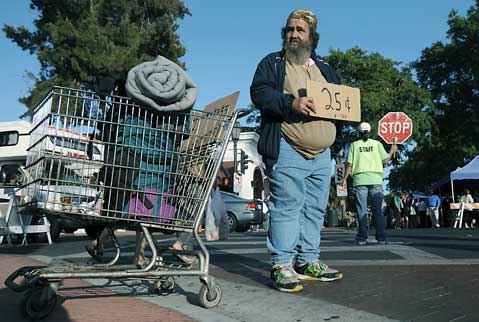Homeless Deaths Hit 20
Council Approves Anti-Panhandling Law

The same week that the number of homeless to die within Santa Barbara city limits in 2009 hit 20-drastically overshadowing the 18 who died in all of 2008-the City Council passed a new ordinance making it illegal for anyone to “actively” panhandle anyone else in a direct, verbal fashion on State Street, Milpas Street, and Cabrillo Boulevard.
The new ordinance also beefed up prohibitions against “aggressive” panhandling- defined by the use of threats, intimidation, or insulting language-anywhere in the city. As a result of the council vote, both active and aggressive panhandling have been elevated from infractions to the status of criminal misdemeanors, punishable by fines up to $1,000 and jail terms of six months. In deference to free speech constitutional concerns, the new ordinance will still allow what’s known as “passive panhandling,” in which individuals solicit donations from passersby without addressing them directly, but instead, by holding up signs or playing music for tips.
The most heated controversy among councilmembers came over when the new ordinance should take effect. By a 4-3 vote, the council majority decided the new ordinance would not become effective until an “alternative giving” program is in place to compete with panhandlers for the spare change of small-time philanthropists. The proceeds of this program are slated to fund social service programs for street people. Development of that program, which involves donation containers on State Street and was initially scheduled to begin this September, has been hamstrung by design review considerations and lack of enthusiasm by the business community. The alternative giving plan is now expected to start early next year.
The new ordinance came in response to growing complaints about increasingly aggressive panhandling in heavily trafficked parts of town and was proposed by an ad hoc subcommittee-led by councilmembers Iya Falcone, Helene Schneider, and Dale Francisco -charged with devising a comprehensive response to the problem of homelessness. After 40 hours of meetings, attended by as many as 100 stakeholders, the committee released its “12-point plan” of action this February, which was endorsed by the City Council. That plan specifically recommended that the tougher panhandling law be linked to an alternative giving plan, so that businesses-at best lukewarm to the idea-would have greater incentive to participate. But by Tuesday, Falcone had a change of heart. “The community is demanding action now,” she declared. With her were councilmembers Das Williams and Roger Horton. Williams, who in past discussions, has taken the business community to task for not embracing the alternative giving plan, expressed profound skepticism over the unsteady pace of its progress. By waiting, he said business owners would be denied the protections they needed, and homeless people would continue to poison themselves with alcohol and crystal meth.
Instead, Williams proposed the ordinance go into effect now, but be suspended in January if the alternative giving program did not materialize. Successfully holding the line for linkage, however, were councilmembers Dale Francisco, Helene Schneider, and Grant House. (Mayor Marty Blum, whose comments seemed to support both positions, ultimately cast the deciding vote their way.) Schneider and Francisco argued that the consensus out of which the 12-point plan had been so painstakingly negotiated would collapse if the deal were tinkered with. As Schneider noted, many had hoped the proceeds would help expand the limited number of detox beds now available to South Coast indigent from 12 to 24.
Skepticism abounds about the program. Alternative giving campaigns in the past have fizzled. And if donation devices were ever placed on State Street as an alternative to those who give to panhandlers, one street person warned that some of his brethren might “take their vengeance out on some crafty piece of art” in order to procure the funds needed “to get their groove on.” While tougher penalties for aggressive panhandling may sound impressive to many, the threat of a six-month sentence is probably more smoke than fire given chronic overcrowding at the County Jail. And a $1,000 fine will be well beyond the ability of most street people to pay.
Meanwhile, Santa Barbara’s homeless death toll continues to climb for the year, attracting the notice of Los Angeles Times columnist Steve Lopez, who reported Santa Barbara’s death toll-now at 20-has surpassed that of Santa Monica, which is 14. The names of the three homeless who died this past week have yet to be released pending notification of next of kin. One of the dead was known as “Guitar Man,” because he regularly played steel guitar on the 1100 block of State Street. His body was found outside on lower State Street. A 58-year-old man died at Cottage Hospital, and a woman in her early fifties died while at the Salvation Army.



